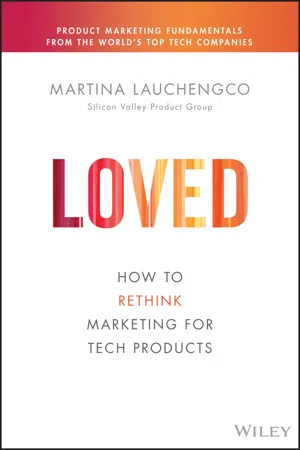
- English
- ePUB (mobile friendly)
- Available on iOS & Android
About this book
Most tech companiesget marketing wrong because they don't know how to do product marketing right. The next in the bestselling SVPG series, LOVED shows what leaders like Apple, Netflix, Microsoft, and Salesforce do well and how to apply it to transform product marketing at your company.
The best products can still lose in the marketplace. Why? They are beaten by products with stronger product marketing. Good product marketing is the difference between "also-ran" products versus products that lead. And yet, product marketing is widely misunderstood. Although it includes segmenting customers, positioning your product, creating product collateral, and supporting sales teams, great product marketing achieves much more. It directs the best way to bring your product to market. It shapes what the world thinks about your product and category. It inspires others to tell your product's story.
Part of the bestselling series including INSPIRED and EMPOWERED, LOVED explains the fundamentals of best-in-class product marketing for product teams, marketers, founders and any leader with a product and a vision.
Sharing her personal stories as a former product and marketing leader at Microsoft and Netscape, and as an advisor to Silicon Valley startups, venture capitalist, and UC Berkeley engineering graduate school lecturer, Martina Lauchengco distills decades of lessons gleaned from working with hundreds of companies to make LOVED the definitive guide to modern product marketing.
With dozens of stories from the trenches of market leaders as well as newer startups with products just beginning their journey, the book shows you:
- the centrality of product marketing to any product's success
- the key skills and actions required to do it well
- the four fundamentals of product marketing and how to apply them
- how to hire, lead, and organize product marketing
- how product marketers optimize crucial collaboration with other functions
- one-sheet frameworks, tools and agile marketing practices that help simplify and elevate product marketing
LOVED is an invitation to rethink tired notions of product marketing and practice a more dynamic, customer and market-centric version that creates raving fans and helps products achieve their full market potential.
Frequently asked questions
- Essential is ideal for learners and professionals who enjoy exploring a wide range of subjects. Access the Essential Library with 800,000+ trusted titles and best-sellers across business, personal growth, and the humanities. Includes unlimited reading time and Standard Read Aloud voice.
- Complete: Perfect for advanced learners and researchers needing full, unrestricted access. Unlock 1.4M+ books across hundreds of subjects, including academic and specialized titles. The Complete Plan also includes advanced features like Premium Read Aloud and Research Assistant.
Please note we cannot support devices running on iOS 13 and Android 7 or earlier. Learn more about using the app.
Information
Part One
The Foundation: Understanding Product Marketing's Fundamentals
Chapter 1
When David Beats Goliath: Why Product Marketing Matters
- Sharing data around shifting trends in consumer behavior. From company blog posts with surprising factoids—for instance, of the thousand most saved videos, the median length was 30 minutes—to showing the press the rapid growth in saving items as mobile device use exploded, the team promoted a customer and market-centered point of view, not just one about their product.
- Connecting their product's purpose with broader trends. They started comparing what they did for web pages to similar shifts. Like how Dropbox changed file sharing or Netflix changed TV. They connected themselves to a much bigger “anytime, anywhere” megatrend, saying “we're the ones who are doing this for Internet content.” They also developed an API that let any app integrate their “save-for-later” functionality, making it an industry standard.
- Rebranding from Read It Later to Pocket. This was a strategic decision designed to help the world see Pocket as bigger than saving articles for later. Changing the product name when they released their 4.0 version was important to show some of their key differentiators—like the ability to save videos and images—and define what was important for products like theirs.
- Making it free instead of $3.99. It's hard to ask people to pay for something when they haven't yet experienced its value. The change was messaged in an authentic blog from its founder, where he also explained they were now a venture-backed startup. It helped cement the trusted relationship Nate had with Pocket's users despite big changes.
- Sharing the “why” and advance access with influencers. Before launching any new version, they made sure to give the most influential evangelists—press, pundits, superfans—the “why” behind the new enhancements, giving new features more meaning.
What Is Product Marketing?
- Fundamental 1: Ambassador: Connect Customer and Market Insights
- Fundamental 2: Strategist: Direct Your Product's Go-to-Market
- Fundamental 3: Storyteller: Shape How the World Thinks About Your Product
- Fundamental 4: Evangelist: Enable Others to Tell the Story
Why Product Marketing Matters Now
Table of contents
- Cover
- Table of Contents
- Title Page
- Copyright
- Dedication
- Foreword
- Introduction: My Story
- Part One: The Foundation: Understanding Product Marketing's Fundamentals
- Part Two: How to Do the Role: Who Should Do Product Marketing and How to Do It Well
- Part Three: Strategist: Guardrails and Levers: The Tools to Guide Product Go-to-Market Strategy
- Part Four: Storyteller: Clarity and Authenticity: The Process and Tools to Rethink Messaging
- Part Five: Advanced Product Marketing and Leadership: How to Do and Lead It Better at Any Stage Company
- Conclusion: What You Can Do Right Now
- Appendix: Marketing Terms Explained
- Acknowledgments
- About the Author
- Index
- End User License Agreement